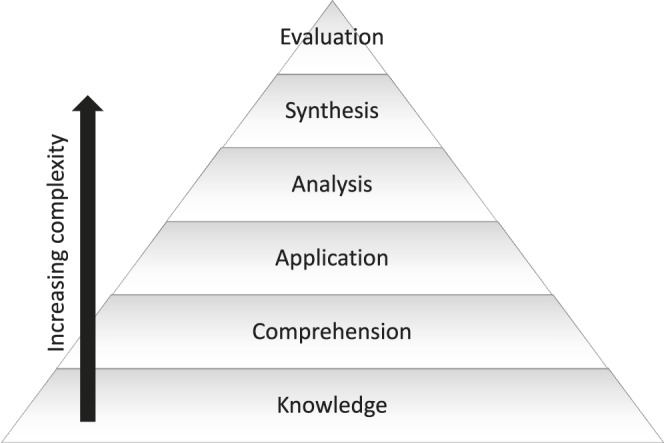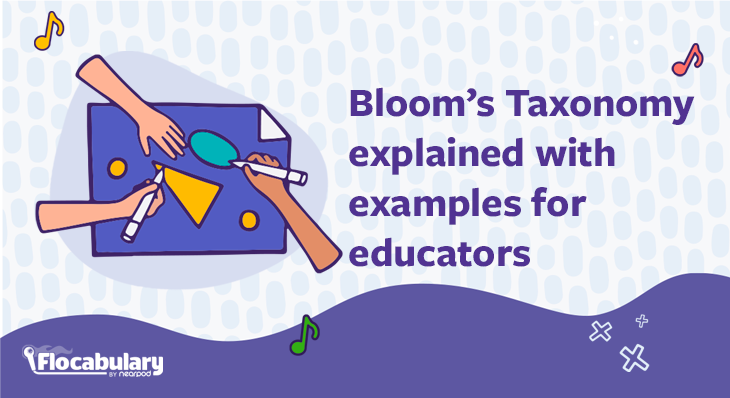
Bloom’s Taxonomy explained with examples for educators
There are many approaches, strategies, and schools of thought (pun intended!) associated with education, learning, and student success. One framework, Bloom’s taxonomy, is a keystone for many educators who want to build higher-order thinking skills while developing student confidence. In fact, it was developed to provide a common language for teachers and educators to discuss and exchange learning and assessment methods.
Keep reading to learn more about Bloom’s taxonomy and how Flocabulary lessons are crafted to follow this tried-and-true method for engaging and empowering students.
What is Bloom’s taxonomy?
In 1956, a group of educators, including psychologist Benjamin Bloom, came together to develop a framework and approach for categorizing educational goals.
Originally called the Taxonomy of Educational Objectives, the framework familiarly known as Bloom’s taxonomy (or simply, “Bloom’s”) has been applied to all levels of education, from K-12 to college and universities, and across numerous subjects and curricula.
The goal of Bloom’s taxonomy is to encourage higher-order thinking in students by first building up from lower-level cognitive skills. Though it is most commonly used to assess learning at various levels, specific outcomes can be derived from the taxonomy.
How effective is Bloom’s taxonomy?
As noted in an article by Nancy Adams, Bloom’s taxonomy approach to cognitive learning objectives can lead to “in-depth learning and transfer of knowledge and skills to various tasks and contexts.” An example of this transference of rote skills to deeper comprehension and understanding can be seen in this study from a graduate student studying education at Oakland University. Assuming the role of an educator, she structured her semester-long course specifically around Bloom’s taxonomy.
The result: students developed a better understanding of the curriculum concepts. Even better, the study showed an increase in engagement.
In summary, Bloom’s taxonomy has proven to be an effective aid and reference for teaching, assessing, and strengthening students’ skills, while keeping them engaged and motivated.
What are the different levels of Bloom’s taxonomy?
Often shaped like a pyramid (recent iterations are shown as a wheel), Bloom’s taxonomy begins with a solid base of critical, lower-level cognitive skills. As the levels build, so does higher-order thinking.
Let’s take a quick trip through each level and how it relates to the learning journey:
1. Knowledge
Knowledge, also known as Remember, is the foundation of Bloom’s Taxonomy. It is the ability to recall learned information on command. This is where rote factual knowledge of specific terminology lives, and from here, we’ll build up our skills and higher-order thinking.
2. Comprehension
At the Comprehension level, also known as Understand, students should be able to understand the meaning of information and materials and be able to translate those materials from one form or format to another.
3. Application
Working our way up, we continue building on previous learnings with Application, also known as Apply. Now, students are capable of applying learned rules, methods, concepts, principles, laws, and theories to solve new problems or respond to concrete situations or prompts that have a single (or best) answer.
4. Analysis
After applying knowledge, it’s time to break it down! Analysis, or Analyze, consists of the multiple components and causes that make up a concept’s full structure and is a critical part of the learning journey, prompting students to dive deeper into the puzzle pieces that make up the bigger picture.
5. Synthesize
Next, we focus on synthesizing, also known as create, to show previously learned skills and knowledge in a new and creative production. By pulling from, utilizing, tapping into, and harnessing everything they’ve built up, students are challenged to think creatively, critically, and curiously to produce new and original work.
6. Evaluate
Capping off the top of the Bloom’s taxonomy pyramid, we reach Evaluate. Here, students are expected to assess the value of ideas, theories, or materials, and provide informed and justified opinions or decisions. This level involves critical thinking skills such as comparing, contrasting, critiquing, and synthesizing information to form well-reasoned conclusions.
Bloom’s Taxonomy explained with examples for educators
Curious how Bloom’s taxonomy comes to life in the classroom? You’re in luck!
We’ve compiled a list of activities that align with each level and included specific Flocabulary features that make it a breeze to engage students and improve outcomes.
Even better: features within Flocabulary can apply to different levels of Bloom’s and can be used in any order, no matter the teacher’s expectations, curriculum outlines, or other considerations.
Designed with Bloom’s in mind, Flocabulary accelerates student learning by building academic vocabulary and comprehension. Engaging, standards-aligned lessons and activities for grades K-12 leverage the power of hip-hop music, storytelling, and emotional connections to cultivate literacy.
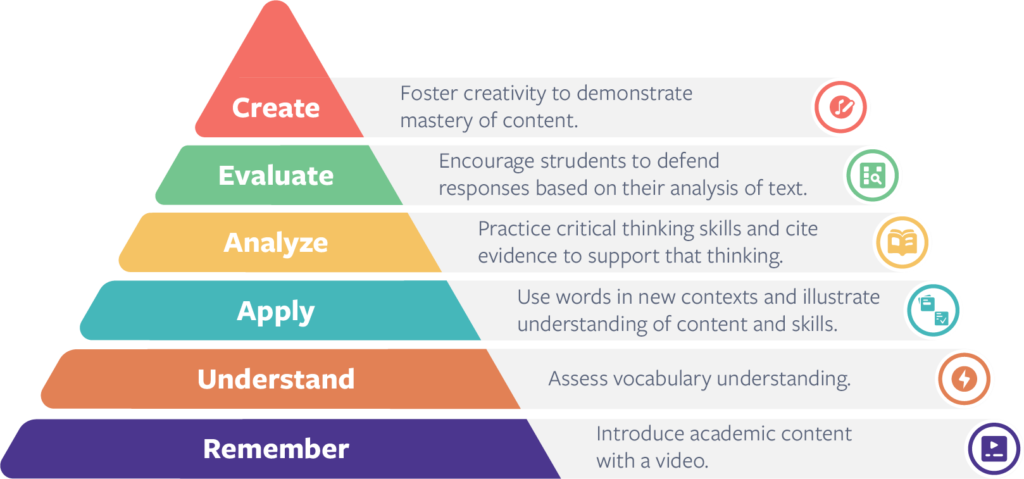
Read on to learn more about Bloom’s and see how Flocabulary supports the learning journey.
Captivate students and make learning experiences memorable and interesting through Flocabulary. Teachers can sign up below to access the activities and lessons shared in this blog post. Administrators can contact us below to learn more about the power of Flocabulary Plus.
1. “Remember” examples
For students to begin building their knowledge, it all starts at the basic “Remember” level. It, therefore, makes sense that some of the most commonly used classroom activities and assessments make up the foundation of Bloom’s taxonomy; these include lectures, memorization, readings, videos, and Q&As.
It’s with videos that Flocabulary kicks off the lesson sequence within Bloom’s taxonomy with a video that uses hip-hop to engage learners in standards-aligned concepts and skills.

The music, repetition, and visual reinforcements provide students with much-needed context and make key vocabulary and lesson content memorable.
All other activities build off this initial video, and students might even return to it to support higher-order thinking as they work their way up.
2. “Understand” examples
Discussions, short assessments such as quizzes, or “check-in”-type prompts are all activities typically found when moving up after initial learnings or the “Remember” level.
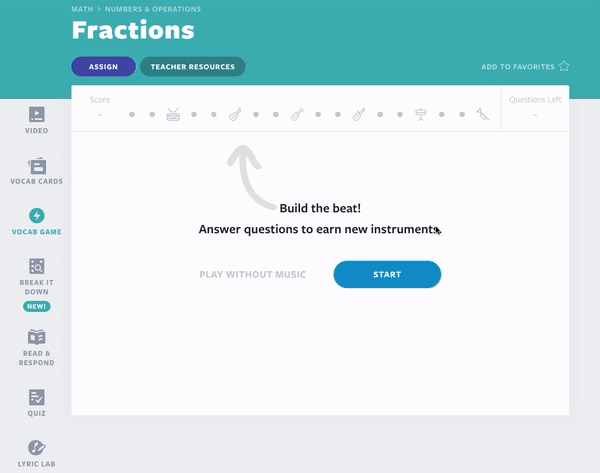
One Flocabulary feature that supports the “Understand” level is the Vocab Games. These activities assess vocabulary understanding and test students’ word knowledge through a variety of interactive exposures.
Using a drag-and-drop activity, Students show their understanding by matching each lesson’s vocabulary to images, definitions, the hip-hop lyrics from the lesson’s video, and more!
3. “Apply” examples
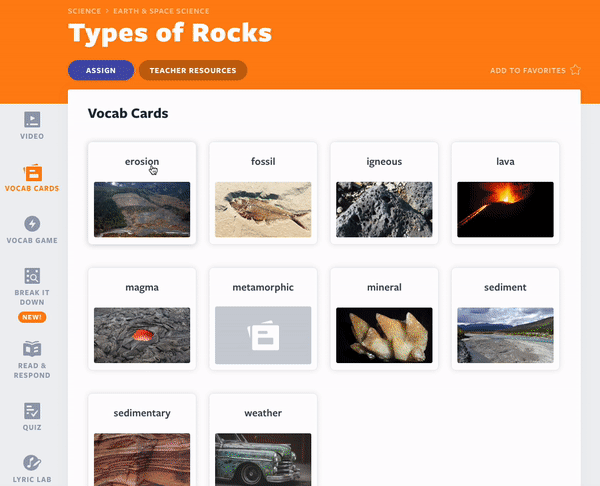
Students have been introduced to, and assessed on, lesson concepts—now it’s time to begin applying what they’ve learned! Activities might include demonstrations or group presentations; illustrating or acting out key lesson concepts; completing a graphic organizer; and problem sets. These activities allow students to practice applying what they’ve learned in new contexts.
Flocabulary supports this level with activities that build context and allow students to illustrate knowledge.

The Vocab Cards activity builds students’ word knowledge as they write sentences and draw illustrations to represent key terms from the lesson. The ability to “build context” and “illustrate knowledge” is applied and assessed as learners work to create their own sentences and drawings. This requires a higher level of thinking; the potential for more than one correct answer provides an extra challenge, too.
Educators can also assess lesson comprehension through Flocabulary’s 10-question auto-graded quiz. Quizzes are opportunities for students to apply what they’ve learned and, in turn, opportunities for teachers to gain insight into where extra practice or attention might be needed.
4. “Analyze” examples
At this stage of Bloom’s taxonomy, it’s important to provide students with opportunities to not only begin demonstrating what they’ve learned, but feel empowered to ask questions, think critically, and even propose alternative solutions or answers.
Simulations or role-playing activities, including labs, situations, debates, and essays, can be ways to achieve the “Analyze” level of Bloom’s.
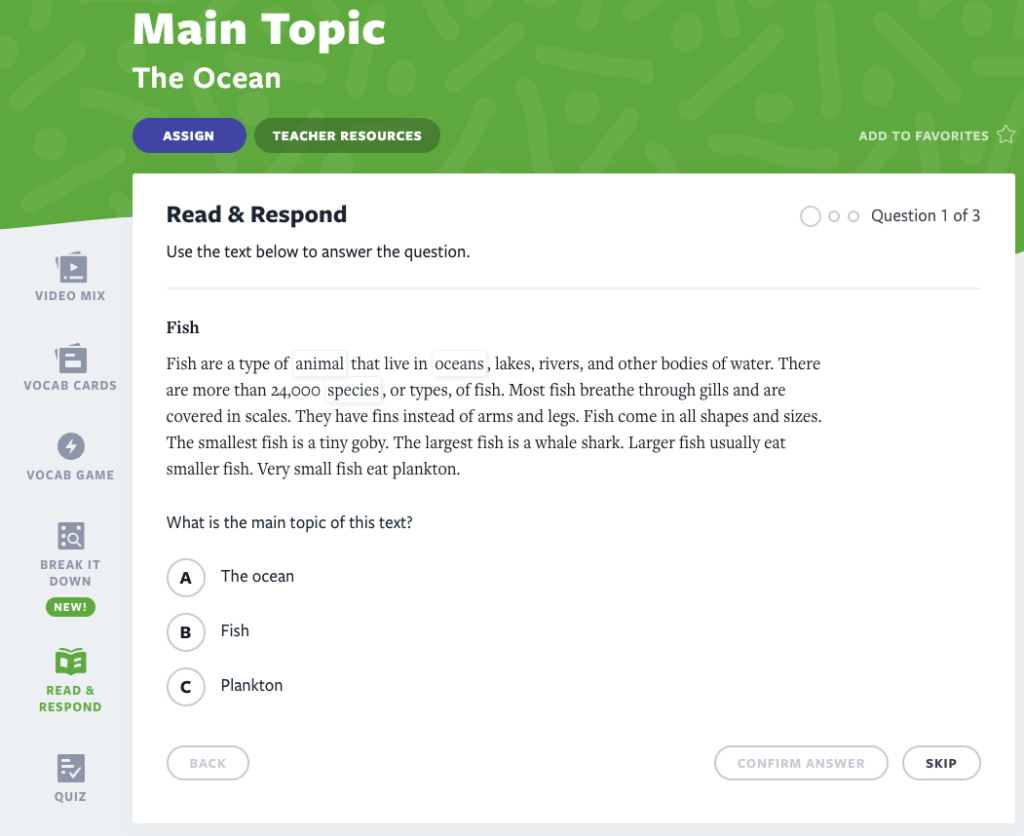
Flocabulary’s lesson sequence includes opportunities for students to analyze text and video, practice close reading, and gather evidence. Two activities that bring the “Analyze” level of Bloom’s to life are Read & Respond and Break It Down.
Read & Respond is an activity that includes short reading passages, followed by text-dependent questions. The questions require students to read closely, look for explicit details, make inferences, and analyze an author’s point of view or argument.
5. “Evaluate” examples
In the Evaluate stage of Bloom’s taxonomy, students are encouraged to develop their critical thinking skills by assessing and critiquing various concepts and ideas. This can be achieved through activities such as peer reviews, self-assessments, or debates where students must defend their viewpoints with solid reasoning and evidence. By engaging in these activities, students not only demonstrate their ability to analyze information but also refine their judgment skills, ultimately leading to deeper understanding and higher-level thinking.
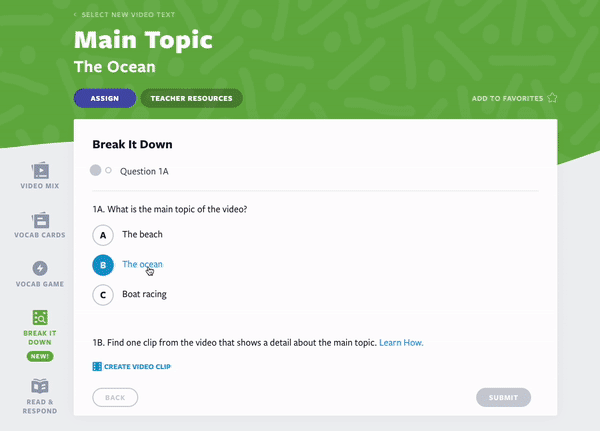
The Break It Down activities ask students to find evidence to support their answers. By finding a video clip that provides a key detail or fact, students go beyond simply applying knowledge to a new context and thinking critically about a text. After finding their evidence, they justify why they chose their answer and analyze how it relates to the prompt.
6. “Create” examples
From artwork and creative writing, and acting to creating media such as videos or music, the “Create” level of Bloom’s serves as a stage for student voices to shine.
The “Create” level is an integral part of assessing student comprehension; here is where they put everything they’ve learned into practice to demonstrate a concept as they develop, plan, prepare, and construct in the creation of something new and original.
Flocabulary’s Lyric Lab activity is the ultimate way for students to foster creativity and demonstrate mastery of content. Here, they draw from everything they’ve done and learned in the lesson sequence as they create an original rap or rhyme of their own.
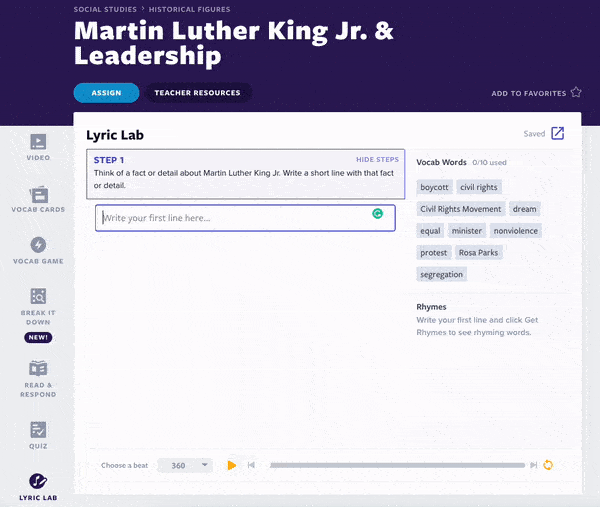
This scaffolded writing experience encourages students to ground their rhymes and music lyrics by creating their own rap using the academic vocabulary covered in the lesson. A built-in rhyming dictionary and beats library help students practice rapping their own rhymes over a beat. There’s always the option for students to download and share what they’ve learned or created with a broader audience beyond their teacher, too.
The best way to learn more about this beloved-by-all feature is to see it in action!
Bring the power of Bloom’s taxonomy into your classroom or school
Feel like a Bloom’s taxonomy expert? We hope you’re more familiar with this effective, scalable educational framework!
Flocabulary is designed to build students’ higher-order thinking skills, leading to improved learner outcomes. And, much like Bloom’s, Flocabulary can be utilized by teachers and administrators across numerous K-12 subjects and curriculums.
Captivate students and make learning experiences memorable and interesting through Flocabulary. Teachers can sign up below to access the activities and lessons shared in this blog post. Administrators can contact us below to learn more about the power of Flocabulary Plus.

